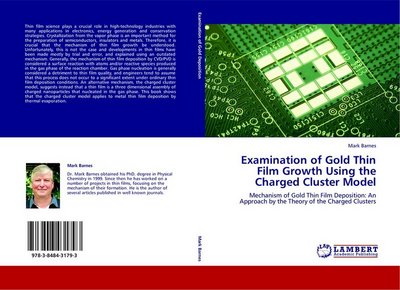Examination of Gold Thin Film Growth Using the Charged Cluster Model
Barnes, Mark C. (2012) Examination of Gold Thin Film Growth Using the Charged Cluster Model. LAMBERT Academic Publishing (LAP), Saarbrucken, Germany.
![[img]](https://researchonline.jcu.edu.au/25225/1.hassmallThumbnailVersion/25225_cover_image.jpg)
|
Image (JPEG) (Cover Image)
- Cover Image
Download (108kB) |
|
|
PDF (Front Pages)
- Supplemental Material
Download (857kB) |
|
|
PDF (Back Pages)
- Supplemental Material
Download (2MB) |
Abstract
Thin film science plays a crucial role in high-technology industries with many applications in electronics, energy generation and conservation strategies. Crystallization from the vapor phase is an important method for the preparation of semiconductors, insulators and metals. Therefore, it is crucial that the mechanism of thin film growth be understood. Unfortunately, this is not the case and developments in thin films have been made mostly by trial and error, and explained using an outdated mechanism. Generally, the mechanism of thin film deposition by CVD/PVD is considered a surface reaction with atoms and/or reactive species produced in the gas phase of the reaction chamber. Gas phase nucleation is generally considered a detriment to thin film quality, and engineers tend to assume that this process does not occur to a significant extent under ordinary thin film deposition conditions. An alternative mechanism, the charged cluster model, suggests instead that a thin film is a three dimensional assembly of charged nanoparticles that nucleated in the gas phase. This book shows that the charged cluster model applies to metal thin film deposition by thermal evaporation.
Research Statement
| Research Background | To meet the increasing demands of industry in areas, such as displays, solar cells, functional coatings, etc., the mechanism for thin film growth needs to be known with more precision. Sadly, this is not the case and developments in thin films have been made mostly by trial and error, and explained using an antiquated mechanism. The theory of charged nanoparticles (TCN) proposes instead that a thin film is a self-assembly of charged nanoparticles that nucleate in the gas phase. |
|---|---|
| Research Contribution | The book proved that gold thin films are formed from charged nanoparticles that have nucleated from the gas phase. The individual nanoparticles were observed and their size was shown to change with the processing conditions. The presence of charge on the nanoparticles was confirmed by bias experiments. Overall, metal thin films are deposited according to the predictions made by the TCN. |
| Research Significance | Thin film science and technology plays a crucial role in high-technology industries. While the major exploitation of thin films has been in microelectronics, there are many growing applications such as communications, optical electronics, coatings of all types, energy generation and conservation strategies, and environmental remediation. The field of nano-materials is one of the most active research fields in the areas of solid-state physics, chemistry and engineering. Recently, the TCN has been confirmed in many preliminary studies. The TCN will revolutionize the thin film industry in as much as that CVD/PVD processes can be approached more fundamentally and systematically than previously possible. |
| Item ID: | 25225 |
| Item Type: | Book (Non-Commercial) |
| ISBN: | 978-3-8484-3179-3 |
| Date Deposited: | 20 May 2013 03:48 |
| FoR Codes: | 09 ENGINEERING > 0912 Materials Engineering > 091207 Metals and Alloy Materials @ 34% 03 CHEMICAL SCIENCES > 0306 Physical Chemistry (incl Structural) > 030602 Chemical Thermodynamics and Energetics @ 34% 10 TECHNOLOGY > 1007 Nanotechnology > 100708 Nanomaterials @ 32% |
| SEO Codes: | 87 CONSTRUCTION > 8703 Construction Materials Performance and Processes > 870302 Metals (e.g. Composites, Coatings, Bonding) @ 100% |
| Downloads: |
Total: 661 Last 12 Months: 15 |
| More Statistics |



